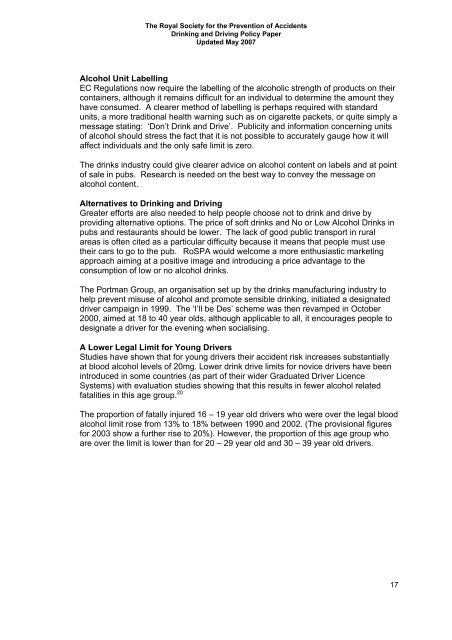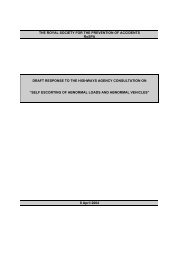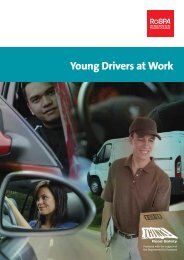RoSPA Drinking and Driving Policy Paper 2007
RoSPA Drinking and Driving Policy Paper 2007
RoSPA Drinking and Driving Policy Paper 2007
You also want an ePaper? Increase the reach of your titles
YUMPU automatically turns print PDFs into web optimized ePapers that Google loves.
The Royal Society for the Prevention of Accidents<br />
<strong>Drinking</strong> <strong>and</strong> <strong>Driving</strong> <strong>Policy</strong> <strong>Paper</strong><br />
Updated May <strong>2007</strong><br />
Alcohol Unit Labelling<br />
EC Regulations now require the labelling of the alcoholic strength of products on their<br />
containers, although it remains difficult for an individual to determine the amount they<br />
have consumed. A clearer method of labelling is perhaps required with st<strong>and</strong>ard<br />
units, a more traditional health warning such as on cigarette packets, or quite simply a<br />
message stating: ‘Don’t Drink <strong>and</strong> Drive’. Publicity <strong>and</strong> information concerning units<br />
of alcohol should stress the fact that it is not possible to accurately gauge how it will<br />
affect individuals <strong>and</strong> the only safe limit is zero.<br />
The drinks industry could give clearer advice on alcohol content on labels <strong>and</strong> at point<br />
of sale in pubs. Research is needed on the best way to convey the message on<br />
alcohol content.<br />
Alternatives to <strong>Drinking</strong> <strong>and</strong> <strong>Driving</strong><br />
Greater efforts are also needed to help people choose not to drink <strong>and</strong> drive by<br />
providing alternative options. The price of soft drinks <strong>and</strong> No or Low Alcohol Drinks in<br />
pubs <strong>and</strong> restaurants should be lower. The lack of good public transport in rural<br />
areas is often cited as a particular difficulty because it means that people must use<br />
their cars to go to the pub. <strong>RoSPA</strong> would welcome a more enthusiastic marketing<br />
approach aiming at a positive image <strong>and</strong> introducing a price advantage to the<br />
consumption of low or no alcohol drinks.<br />
The Portman Group, an organisation set up by the drinks manufacturing industry to<br />
help prevent misuse of alcohol <strong>and</strong> promote sensible drinking, initiated a designated<br />
driver campaign in 1999. The ‘I’ll be Des’ scheme was then revamped in October<br />
2000, aimed at 18 to 40 year olds, although applicable to all, it encourages people to<br />
designate a driver for the evening when socialising.<br />
A Lower Legal Limit for Young Drivers<br />
Studies have shown that for young drivers their accident risk increases substantially<br />
at blood alcohol levels of 20mg. Lower drink drive limits for novice drivers have been<br />
introduced in some countries (as part of their wider Graduated Driver Licence<br />
Systems) with evaluation studies showing that this results in fewer alcohol related<br />
fatalities in this age group. 20<br />
The proportion of fatally injured 16 – 19 year old drivers who were over the legal blood<br />
alcohol limit rose from 13% to 18% between 1990 <strong>and</strong> 2002. (The provisional figures<br />
for 2003 show a further rise to 20%). However, the proportion of this age group who<br />
are over the limit is lower than for 20 – 29 year old <strong>and</strong> 30 – 39 year old drivers.<br />
17
















